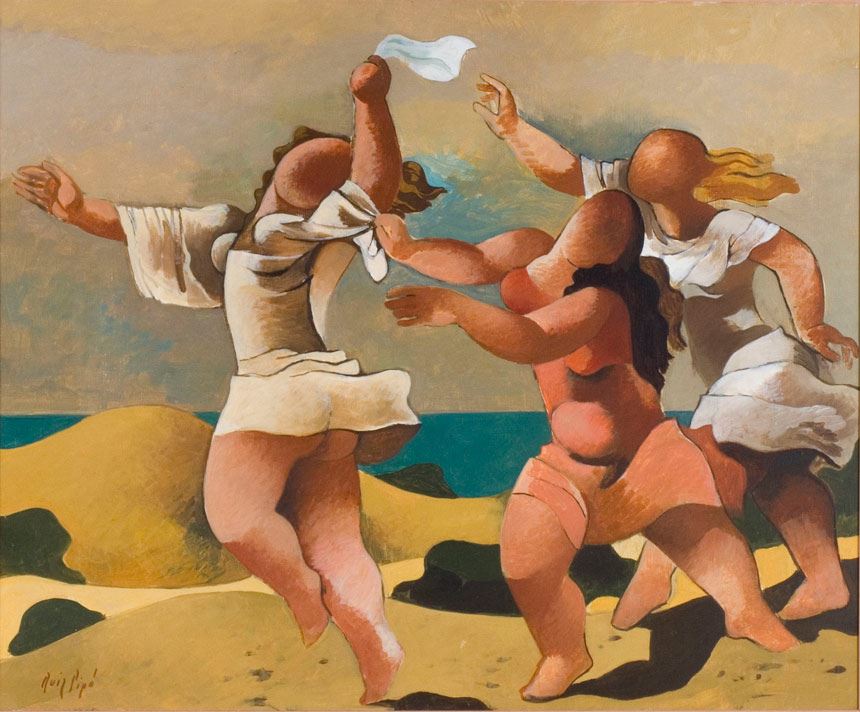Manolo Ruiz Pipó: private dreams public collections

Manolo Ruiz Pipó was born in 1929 in Granada, Andalusia in the south of Spain. From the time he was a small child he had a strong interest in drawing. His family was well-to-do and he was sent to exclusive schools in Granada however, he was frequently expelled from the classroom because he neglected his schoolwork preferring to spend his time drawing caricatures of his teachers and classmates.
One night in 1936 during the turbulent prelude to the Spanish Civil War (1936-1939) Ruiz Pipó’s father was violently taken from his home due to his political beliefs. No one would see him again. In 1940 Pipó’s mother moved her family to Barcelona where they found safety under the protection of her father. In 1942 with the support and encouragement of his grandfather Ruiz Pipó began his formal training in drawing at the Arts and Crafts school La Llotja in Barcelona, the same school where Picasso had been a student.
Two years later Ruiz Pipó received a scholarship to study at San Jordi, the Fine Arts Centre of Barcelona, where his studies included anatomy and dissection; painting in oil tempera, encaustic and fresco; wood and stone carving. At the end of his studies he found work in metallurgy where he would be able to use his skills in sculpture. Ruiz Pipó was employed in an electric lamp factory in Barcelona, where he quickly acquired skills in cutting, welding and working with metal. After four years he gained employment in a restoration and decoration workshop. This work included painting, copying and restoring old masters; sculpting and repairing gold frames; preparing canvases and so on. During this time he continued to draw and sketch prolifically.
Art was held in high regard in Barcelona, therefore it is not surprising that Ruiz Pipó´s works were appreciated there. He was only seventeen years old when he began exhibiting. In 1953, in his early twenties, the Macarron Gallery in Madrid organized a solo exhibition with great success, and the following year he exhibited in Barcelona in Galería Argos alongside Picasso, Juan Gris, Joan Miró, Salvador Dalí and Emilio Grau Sala. At this time Ruiz Pipó felt he needed to leave Barcelona to extend his knowledge and experience of the art world. Following the steps of other artists who moved to Paris in the 1950s, he left Barcelona with a letter of recommendation to visit Picasso. Ruiz Pipó was already familiar with Picasso’s early work as he had seen the Blue and Rose period drawings in Barcelona at the home of art collector Sebastian Junyer. Ruiz Pipó said “In my opinion, this is the first time in art history that someone appears who has destroyed everything so that others might be able to reconstruct it”[i].
In 1954 Ruiz Pipó arrived in Paris and enrolled in the Georg Printmaking Workshop where he learned the techniques of drypoint, mezzotint, aquatint and lithography, and became a master printmaker. Ruiz Pipó discovered Paris and its museums where he studied the works by Georges de la Tour, specifically his night scenes illuminated by candles. Ruiz Pipó was influenced by the contrast of dark and light, known as chiaroscuro, an element he would later use to express sorrow and solitude in his figures.
In this untitled etching a couple eat in silence, the lamp light illuminates their faces and reveals the mood of the couple; she is pensive, with an empty glass in her hand, while the man eats a frugal dinner. This composition is one seen frequently in modern art in works by Paul Cezanne, Vincent van Gogh and Picasso. In Ruiz Pipó’s etching the couple do not look at each other - the tension of the scene is enhanced by the enigmatic shadow of the man projected on the right hand side of the composition. The bread, wine and eggs on the table are recurrent symbols for Ruiz Pipó. The egg represents the origin of life and for Ruiz Pipó “the transformation of the grain in bread is like a miracle of alchemy and the wine brings intoxication and happiness.”[ii]
It has been said that the southern sensibility of the Andalusian is marked by a strong element of pessimism, the origins of which are to be found in the harsh economic and social conditions of the south. In addition, the strong influence of Oriental and Arabic culture, specifically the Mudejar, has contributed to this cultural mix. In contrast to pessimism, the Andalusian spirit embraces joy, and according to Art Historian Armando Grinesi this spiritual content gives life to the whole of Manolo Ruiz Pipós pictorial work, and particularly to the drawings from which the ten lithographs Man Enslaved were extracted. Ruiz Pipó places his “slave” characters in a reality, one dominated by the extremes of light and dark and by the feeling of entrapment. As the Milanese critic Marco Valsecchi expresses, “by recalling cultural supra-worlds, by dreams, by boundless ideals and mental ironies Ruiz Pipó creates an atmosphere of quiet delirium and immobility.”[iii]
Like Diego Velazquez, Joaquin Sorolla, Francisco Goya and Picasso, Ruiz Pipó follows the Spanish tradition of figurative art with still life, nudes, beach scenes, characters drawn from drama as well as tauromaquia (bullfighting). It is not surprising that as a Spanish artist Ruiz Pipó included the bull in his iconography. An etching titled Les Prétresses (The Goddesses) shows a placid bull surrounded by three female nudes. The crown of leaves worn by one of the women gives this image a classical reference. For centuries, the bull has been a symbol of strength, tenacity, virility and power, represented in this image by the elaborate and dense crosshatching of the bull while the female figures are represented with elegant and simple lines. This work also recalls Picasso’s Minotaur series.
Women were a favourite subject for Ruiz Pipó, appreciated for their sensuality and for their fertility. He considered women to be pleasure givers and lovers, however he also expressed tenderness between women. In Ruiz Pipó’s paintings women manifest a symbolic connection with both water and the earth, as depicted in The Rocks and Eva Marina which were both painted in Newcastle. Voluptuous forms blend with the landscape without losing any of their sensuality.
The influence of Picasso on Ruiz Pipó seems inevitable. El Pañuelo (the handkerchief), has a strong reference to Picasso´s oil painting The Race 1922 where two women run along the beach holding hands. Their voluptuous bodies form a triangular composition which Ruiz Pipó reverses in his composition El Pañuelo. Like Picasso, women for Ruiz Pipó were his primary muse. He portrayed them as Mediterranean goddesses - exuberant, curvaceous and as the Italians say “fruta di terra”.
Ruiz Pipó described himself as a “sedentary nomad”. He was a reluctant traveller who nevertheless embraced opportunity and his talents, in particular his skilled portraits, took him to London in 1958 where he was invited to paint the portraits of a high society Englishman and his daughters. This commission led to more work and he began to share his time between Paris and London until 1962. In 1966 he was invited to exhibit in Florence at the Arno gallery. He fell in love with Italy and in 1969 moved to Bologna with his family, where his son Orlando was born. Orlando is depicted in Orlando y la Copa de Cristal (Orlando and the Crystal Glass)painted in 1973.
The theme of mother and child was a leitmotiv for Ruiz Pipó and three maternity paintings are included in this exhibition. The use of red for Ruiz Pipó was an evocation of Bologna, as he stated, “Bologna is where my colours have humanized”. Sensuous, generous and red, Bologna for Ruiz Pipó was the cradle of artistic creation. He used Red Sienna and Carmine to create the maternity paintings, where both mother and child are reduced to stylised bodies composed of circles and ovals. In Armonía en Rojo, the composition of mother and child is reminiscent of the classical tradition of the Madonna.
Pierrot Lunaire is a recurrent subject in Ruiz Pipó’s paintings. Pierrot, the sad clown dressed in white, originates in the 15th century when groups of traveling performers known as Commedia dell'arte travelled and performed throughout Italy. Ruiz Pipó portrays Pierrot immersed in a surrealistic atmosphere where the influence of Giorgio de Chirico is keenly felt in the classical architecture, the use of shadows and the often unlikely juxtaposition of figures and objects. Pierrot evokes the dream state and for the Surrealists the exploration of the unconscious mind, pioneered by Sigmund Freud, which was a way to liberate the imagination from the dominance of reason. In his untitled watercolour Ruiz Pipó uses the Surrealist device of metamorphosis to show the roots of a tree transforming into the face of a sleeping woman.
In Ruiz Pipó we have an artist who condenses the artistic influences of his time and reflects the cultural temperament of both his country of birth and the myriad locations to which he travelled.
This exhibition Manolo Ruiz Pipó: private dreams, public collections is a testimony to the philanthropy of Dr. William Bowmore (1909-2008) who endeavoured to broaden the cultural life of Newcastle. The two men met in Milan where Bowmore purchased several paintings, drypoints and lithographs by Ruiz Pipó. The two men shared a love of art and a mutual appreciation for music. Bowmore and Ruiz Pipó developed a strong friendship and travelled together throughout Italy visiting the Pompeii frescoes. Bowmore invited Ruiz Pipó to Australia and organized two exhibitions of his work in Newcastle. From 1972 to 1975 the artist visited Australia several times and Bowmore’s circle of friends and relatives were introduced to Ruiz Pipó, with many becoming collectors of his work.
I would like to extend my appreciation to all of the lenders - to Maitland Regional Art Gallery, Muswellbrook Regional Arts Centre, Joseph Abraham, Lorna Denham, Gerald Gamble, Dr Peter Hendry, Mark Raschke, and the Kalokerinos family. This exhibition also pays tribute to the late Jocelyn Kalokerinos whose recent donation of two major paintings by Ruiz Pipó, along with the profound generosity of Dr William Bowmore, provided the momentum for this exhibition.
Dr. Susana Enríquez
January 2009












